27.09.2019
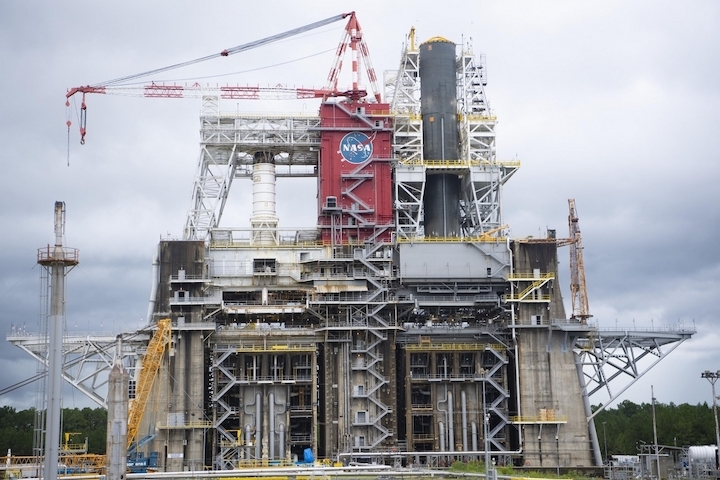
NASA and its contractors recently completed a dress rehearsal of shipping the first Space Launch System (SLS) Core Stage from the Michoud Assembly Facility (MAF) in New Orleans to the Stennis Space Center in Mississippi, where technicians practiced lifting a full-scale replica and placing it in the B-2 Test Stand where the real stage will be tested next year.
The civilian space agency’s Pegasus barge is now transporting the simulator to the Kennedy Space Center (KSC) in Florida where the Exploration Ground Systems (EGS) team there will run through similar crane lifting procedures in the Vehicle Assembly Building (VAB) for Artemis 1 launch processing next year.
The Core Stage Pathfinder has the same size, shape, weight, and balance as a dry flight article, and was built to allow a detailed rehearsal of the transportation and crane operations before doing them with the first flight article. A dry Core Stage weighs over 100 metric tons, as much as Space Shuttle Orbiters did during flight, and NASA is employing a custom overland transportation system to carry it.
The Multi-Purpose Transportation System (MPTS) has also been used during SLS Stages development in conjunction with Pegasus to shuttle test hardware and other program flight elements between factories and test centers. In April, the Pathfinder was loaded on the MPTS the industrial area at MAF and then moved to the dock by remotely-controlled “self-propelled mobilized transporters” (SPMT), where it was loaded onto Pegasus for the relatively short trip to Stennis, where the test article was unloaded from the barge.
Crews at Stennis in August began a series of lifts of the Pathfinder, both off and back on to the transportation equipment, which culminated in a full sequence where the test article was rotated by two cranes from horizontal to vertical. The larger of the cranes, the test stand derrick, then lifted the Pathfinder into the B-2 position of the test complex where it was bolted into the test stand.
After fit and functional checks of hold-down and test equipment in the stand, the Pathfinder was removed and placed back on the MPTS in early September for loading back on Pegasus for the trip to Florida.
Pathfinder practice at Stennis complete
“All operations with the Core Stage Pathfinder are complete,” Marc Neely, Core Stage Green Run Test Operations and Execution Manager for NASA, said in an email regarding work at Stennis. “All objectives were met so no additional installations of the Pathfinder are planned. It was removed from the stand on Aug. 29 and has been placed into its mobile transport system and prepared for its journey to KSC.”
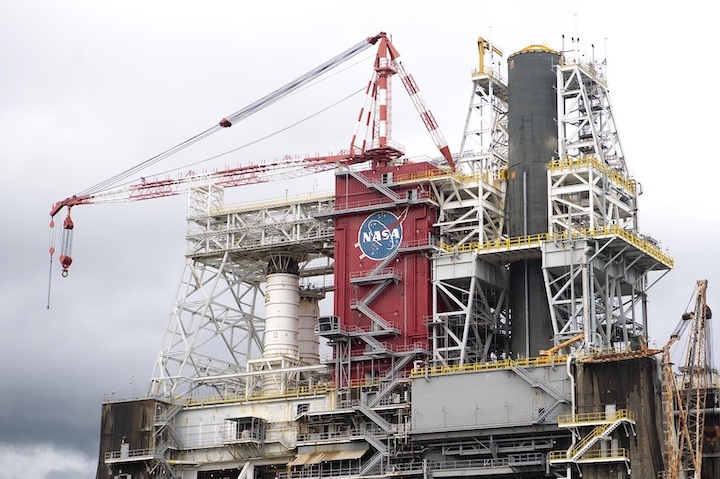
(Photo Caption: NASA’s Core Stage Pathfinder in the B-2 position of the test stand at the B Test Complex at Stennis Space Center on August 26 following installation. The stand is a dual-position facility that supports liquid hydrogen, liquid oxygen engine and stage testing. The B-1 position is currently used by United Launch Alliance to acceptance test individual RS-68 engines. The B-2 position has been used for testing stages from the Saturn V S-IC, to the Delta 4 Common Booster Core, to the Space Shuttle Main Propulsion Test Article.)
The Pathfinder is a full-scale mockup of a Core Stage. It has no moving parts, but does mimic the weight, center of gravity, size, and shape of a dry stage flight article.
The exterior is also outfitted with low-fidelity versions of the larger protuberances on the stage, such as mock-ups of the two liquid oxygen (LOX) feedlines on opposite sides and the systems tunnel that runs much of the length of the stage on its -Z side.
“The test article was ready for installation when it arrived,” Neely noted. “Installation was performed soon after the final piece of ground support equipment (GSE) required for the lift was delivered.” In the interim time, one of the tasks was for technicians to practice installations of a lift spider on the front of the test article, representing the mating flange on the forward end of the forward skirt.
The lift spider is the fixture used to do crane lifts and breakovers of the stage; in addition to supporting vertical installation of the stage into the B-2 Test Stand at Stennis for acceptance tests, a lift spider will be used in the VAB at KSC during pre-launch ground operations to stack the stage with the launch vehicle’s two Solid Rocket Boosters (SRB). The fixture is too heavy to let hang off the end of either a flight article or the Pathfinder while they are horizontal, so additional ground equipment is used to the bear its weight.
An initial lift was conducted to practice removing the Pathfinder from its horizontal transportation carrier, raising it horizontally above it, and then putting it back down in the carrier.
“One horizontal lift was performed August 13 to confirm and record some crane data pertinent to breakover predictions,” Neely said. “Another horizontal lift was performed and continued into the breakover (one total) with continuous operations for installation into the B2 test facility as accomplished on August 24.”
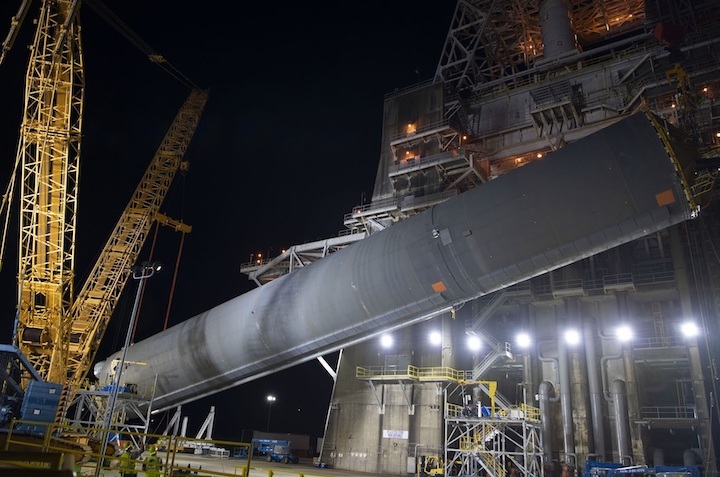
(Photo Caption: The front end of the Pathfinder is raised during the two crane breakover operation at Stennis on the night of August 24 to rotate the simulator to vertical from horizontal. A commercial crane is connected to the aft end of the Pathfinder (left) where the engine section is on a flight article. The test stand derrick crane is connected to the forward end (right) via a lifting fixture which is heavily shadowed in this image. The orange placards indicate the position of access doors on the -Z side of the stage. The rectangular protuberance running the length of the simulator is a low-fidelity representation of the profile of the systems tunnel.)
Neely also said the lift, breakover, and installation operations performed on August 24 were done overnight when weather is generally more favorable. “There is a wind limit for the operation and wind speed is generally lower from midnight to noon,” he noted.
The dual-position stand at the Stennis B Test Complex has a derrick crane at the top, which was connected to the lift spider on the forward end of the stage. A commercial crane was connected to breakover fixtures similar to ones on the engine section of the first flight article at the aft end of the stage.
The two cranes lifted the test article horizontally up high enough to break it over from horizontal to vertical, with the derrick crane on the stand raising the top of the Pathfinder up and the trailing crane helping rotate it to vertical. Once the Pathfinder was in a vertical orientation, the trailing crane was disconnected and the stand’s crane lifted the Pathfinder up, pivoted it into the B-2 position, and lowered it down for install.
For installation the test article was oriented with the -Z side facing to the north and the +Z side facing to the south. This also oriented the structural attach points properly for the final phase of the installation where the article was secured in the stand by bolting the attach points to hold down structures in the stand. Once that was completed, the crane was disconnected from the lift spider.
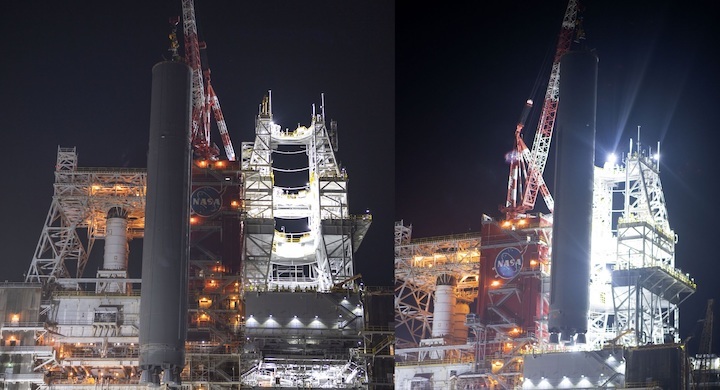
(Photo Caption: The test stand derrick crane finishes vertical installation of the Pathfinder following the initial lift and breakover. The crane continued to lift the test article while pivoting it over to the B-2 position; this also clocked the Pathfinder to line up all the physical connection points. In addition to two pairs of upper and lower hold-down points that lock the stage in the stand, the stand will service the stage via the same four Core Stage umbilicals on the Mobile Launcher at KSC: two tail service plates in the engine section and one each in the intertank and forward skirt.)
The Pathfinder was locked down in the stand for a few days. “The Pathfinder Vehicle objectives were to confirm the correct placement and ability to secure the vehicle at the Solid Rocket Booster hold downs for the forward attachments and the aft attachment points,” Barry Robinson, B-2 Test Stand Core Stage Test Project Manager for NASA at Stennis, said in an email. “It was also used to verify the proper clearances from all fixed and movable platforms and structures.”
The test article also allowed for additional fit checks of parts of the newly renovated B-2 position. “Confirmation of access points located at the forward skirt, the intertank, [and] engine access areas, as well as at the four different umbilical connection points with the facility,” Robinson noted.
“The engine work deck was closed to confirm the correct placement and clearance for any pre/post-test work in those areas,” Robinson added. “Manlifts and scissor lifts were used to verify the ability to reach work areas at elevations where no platforms exist.”
“As an added bonus, the Hydrogen Burn Off Igniters were also deployed to confirm their coverage at the designated nozzle areas.”
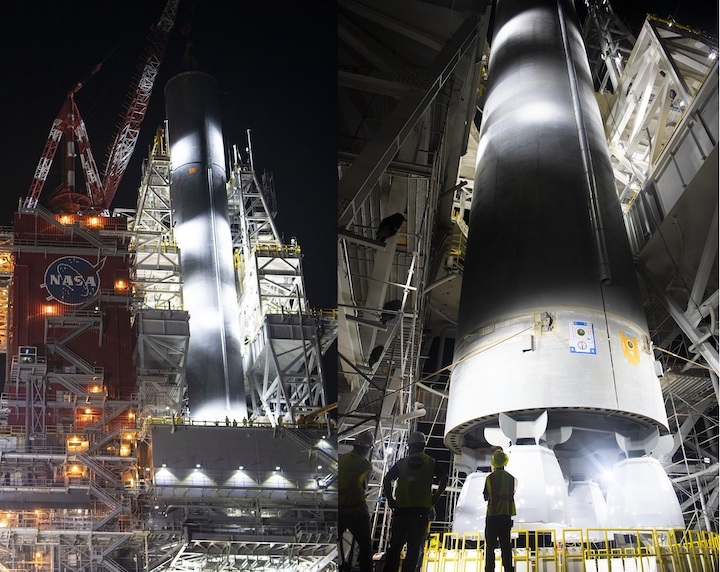
(Photo Caption: The Pathfinder is lowered into the B-2 position by the test stand derrick crane. In the image on the right, placards indicate the position of the two tail service mast umbilical plates on the +Z side of the stage.)
The B-2 position was brought out of mothballs to perform full, end-to-end ground acceptance checkouts of integrated SLS Core Stage units in a test campaign called a Green Run. Flight articles will go through a full countdown, launch, and ascent sequence on their own at Stennis.
The first flight article being completed at MAF is also the first working Core Stage article for the SLS Program, so this first Green Run campaign will involve deliberately checking out the stage, fully loading it with its cryogenic propellants for the first time, and going through a test countdown. The first test with propellant will verify that systems are behaving to specification and provide real performance data to compare with and inform current analytical models.
The campaign culminates in the first and only planned full-duration firing of a Core Stage before the program’s first launch of Artemis 1.
+++
NASA SLS Core Stage shipping and handling practice to move from Stennis to KSC
Before the checkouts at Stennis, NASA’s Core Stage transportation elements first went through a full dress-rehearsal in late April and early May for the sequence of moves that they’ll be making with Core Stage-1, the first flight article when it leaves MAF to get ready for Artemis 1.
Pathfinder was shipped to MAF on a commercial barge two years ago and sat outside during its time there. Delays in the assembly of the first Core Stage flight article and completion of the STAs meant that some get-ahead fit-checks inside the Michoud facility were not performed.
On April 26, the Pathfinder was driven out to the Pegasus barge for a run-through of the trip to Stennis. Starting outside the west end of Building 103, the MPTS carried the Pathfinder on an approximately mile-long route on the streets inside MAF to the dock where Pegasus was berthed.
The move from the industrial area at MAF out to the Pegasus barge was the first major usage of the simulator to checkout the MPTS elements for the first time using the equipment that will carry Core Stage-1 late this year to Stennis.
Due to their size, most of the flight and structural test articles (STA) are shipped horizontally, with the article bolted into NASA’s Multi Purpose Transportation System (MPTS).
Rocket structures are also generally optimized for the loads they take during launch and ascent, not so much for ground transportation. The MPTS is GSE that allows for careful transport of the large Core Stage hardware. Structural support hardware attaches from the flight/test hardware to the remotely-controlled SPMTs.
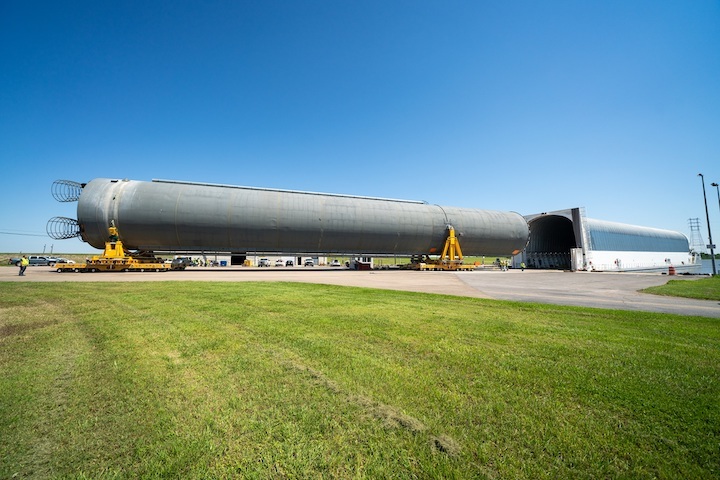
Photo Caption: Pathfinder is lined up by the four SPMTs to roll onto Pegasus at the dock at MAF on April 26. The simulator has the same dimensions, weight, and center of gravity as a flight Core Stage article. On the Pegasus barge, the carriers at the front and back are positioned over eight structural connection points where the SPMTs lower them onto pedestals at each point to secure the carrier and stage to the barge deck. After the SPMTs let go, they are driven to the middle of the barge and chained down to the deck during water transportation.)
The stage STAs were built and tested as individual elements (engine section, intertank, LH2 tank, and LOX tank), with simulators on both ends of the qualification article attached to hardware interface structures (HIS). For handling them, a common HIS is attached on both ends to the simulators and each HIS is attached to a table-shaped multipurpose carrier (MPC).
As commanded by nearby operators, four remotely-controlled SPMTs roll underneath the MPCs (two for each) and pick them up to move the whole assembly.
A different MPTS configuration is used for a full Core Stage. A common HIS connects to one MPC via transportation fixtures on the engine section similar to the STAs, but two forward HIS elements connect the forward end to the other MPC via the SRB forward attach points on opposite sides of the intertank.
Pegasus trip to Stennis in May
Pegasus carried the Pathfinder from MAF to Stennis in early May. “We came out here to Intercoastal Waterway, we took a left, it’s right here, and then we followed that until we got to the Pearl River and then we turned left on the Pearl River and went all the way north to Stennis,” Alan Murphy, NASA Marine Operations Lead, said at MAF in late June. “That’s about a 12-hour trip, if we time the bridges right.”
Originally built in 1999, Pegasus was used to transport Space Shuttle External Tanks from MAF to the Kennedy Space Center (and in a few cases, the reverse). It was two-hundred sixty feet long at the end of the Shuttle era, but SLS Core Stages are almost sixty feet longer than Shuttle tanks and much heavier, so the middle section of the barge was removed and replaced with a reinforced section fifty feet longer designed to handle the higher cargo weight, bringing the overall length to three-hundred ten feet.
“That goes back to the weight of this as it loads on versus the External Tank,” Murphy explained. “External Tank was fairly light, especially the mover part of it.”
“The SPMTs and the MPC and the HIS, which is the hardware interface structure that goes up, all those are really beefy compared to what External Tank used, so with all that extra weight going across the ocean, you have the stress engineers who evaluated it and said we need a thicker deck and we need more supports underneath, so it made more sense to be able to replace that whole section where this is going to be sitting.”
Although the propellant tanks are a prominent feature of the Core Stage, they are only part of its role in the launch vehicle. The stage plays the same combined role as the Orbiters and the External Tank did for the Space Shuttle during its ascent to orbit.
Not only are the propellant tanks themselves are significantly bigger to hold more fuel, but the stage includes a bigger engine compartment resized from the Shuttle Orbiter back end that contains most of the Main Propulsion System and four RS-25 engines in the back. The stage also includes the flight computers upfront and navigation equipment and avionics throughout that serve as the brains of the launch vehicle from liftoff to insertion into Earth orbit.
The Pathfinder was constructed to the estimated 228,000-pound dry weight of a Core Stage, which is about the weight of four last-generation External Tanks or a flight-ready Shuttle Orbiter. The heavier vehicle requires stronger, heavier carrier equipment, which increases the overall load that Pegasus has to carry.
“We have eight pads in there, which was part of the modification we did several years ago in the shipyard,” Murphy noted. The pads have I-beams up underneath, really a lot of support on there to take all the loads we might see on the ocean. That’s part of the reason we went to the shipyard, we had to be able to compensate for the ocean loads, the more weight that we have here versus External Tank, and the extra length.”
For the full stage article or a full-scale simulator like the Pathfinder, when the SPMTs lower the full carrier to release them, the MPCs are set down on eight pedestals, such as when securing the vehicle and MPTS to the deck of the Pegasus. “Those pedestals are kind of interesting because it’s got three-hundred and sixty degrees of adjustment that we can make on them, so when you roll this thing in, if you’re off a little bit we can actually slide those and then we’ve got slots on those you can bolt these pedestals down once you get those on,” Murphy said.
“This was the first time that we tested out the pedestal system, that’s with the Core Stage or the Pathfinder in this instance, which is the same size as the Core Stage, sitting down on the pedestals. Instead of the chaining that you see on the STA where we’re chaining it to the surface, we have to go with a more robust system and that is with the eight pedestals that we have underneath.”
“The Core Stage will roll on and we’ll bolt them down,” he added. “The reason we do that is because we have ocean loads that we have to go through going from here to Kennedy Space Center.”
Murphy noted that with the STAs, a set of “legs” were instead attached to the MPCs that moved with the carrier assembly.
With the shipping and handling practice at MAF and Stennis completed, Pathfinder was loaded back on Pegasus at Stennis for the first ocean trip through the Gulf of Mexico and around the Florida Peninsula to Kennedy Space Center. “You’ve got the Pearl River on this side and when you get over to KSC you’ve got the Banana River, so we’ll go through a lock there,” Murphy said.
“When we get on the ocean we have one big tug. It won’t be a pusher, it will be a puller and it’ll be about a half a mile in front of us, so once we get to the Banana River we can’t use that puller so we have to get two more tugs over there to take us through the Banana River to KSC.”
The barge is currently scheduled to arrive at KSC on Friday, September 27, where the next set of practice sessions for handling a Core Stage will be held.
Quelle: NS
